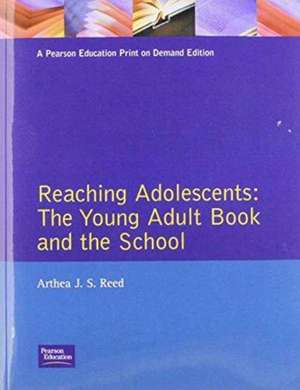Reaching Adolescents: The Young Adult Book and the School
Autor Althea J. Reeden Limba Engleză Paperback – 21 oct 1993
An exciting new young adult literature text...one that offers a holistic, inclusive approach to incorporating the popular books young adults like to read into a solid English language arts curriculum. A student-centered, whole language emphasis advocates a curriculum that encourages student response to literature and helps develop crucial critical thinking skills. The author suggests numerous approaches to using young adult literature, explores and demonstrates a variety of teaching methods, and discusses an array of literature appropriate for a wide range of students in a number of subject areas, including literature written specifically for children and young adults, popular adult literature, and the classics.
Preț: 456.13 lei
Preț vechi: 563.13 lei
-19% Nou
Puncte Express: 684
Preț estimativ în valută:
87.29€ • 90.62$ • 72.79£
87.29€ • 90.62$ • 72.79£
Cartea nu se mai tipărește
Doresc să fiu notificat când acest titlu va fi disponibil:
Se trimite...
Preluare comenzi: 021 569.72.76
Specificații
ISBN-13: 9780023988615
ISBN-10: 0023988614
Pagini: 624
Dimensiuni: 193 x 241 x 32 mm
Greutate: 1.63 kg
Ediția:1
Editura: Pearson Education
Colecția Allyn & Bacon
Locul publicării:Boston, United States
ISBN-10: 0023988614
Pagini: 624
Dimensiuni: 193 x 241 x 32 mm
Greutate: 1.63 kg
Ediția:1
Editura: Pearson Education
Colecția Allyn & Bacon
Locul publicării:Boston, United States
Cuprins
I. A RATIONALE FOR USING YOUNG ADULT LITERATURE.
1. Young Adult Literature: A Bridge to Maturity.
2. The Young Adult Book as a Motivational Tool.
II. LITERATURE FOR YOUNG ADULTS.
3. Realistic Fiction.
4. Coming-of-Age Novels.
5. Across Time and Culture.
6. Adventure and Romance.
7. Imaginative Literature.
8. Nonfiction, Poetry, Short Stories and Drama.
III. THE YOUNG ADULT BOOK AND THE SCHOOL: CURRICULUM AND METHODOLOGY.
9. Young Adult Literature in English and Language Arts.
10. Young Adult Books Across the Curriculum.
11. Responding to, Experiencing and Sharing Young Adult Books.
12. Teaching Skills and the Young Adult Book: An Inclusive Approach.
13. Bridging the Classics.
IV. REVIEWING AND SELECTING YOUNG ADULT BOOKS.
14. Selecting and Obtaining Young Adult Books.
15. Censorship and the Young Adult Book.
Appendixes.
Bibliography.
Title, Author, and Subject Indexes.
1. Young Adult Literature: A Bridge to Maturity.
2. The Young Adult Book as a Motivational Tool.
II. LITERATURE FOR YOUNG ADULTS.
3. Realistic Fiction.
4. Coming-of-Age Novels.
5. Across Time and Culture.
6. Adventure and Romance.
7. Imaginative Literature.
8. Nonfiction, Poetry, Short Stories and Drama.
III. THE YOUNG ADULT BOOK AND THE SCHOOL: CURRICULUM AND METHODOLOGY.
9. Young Adult Literature in English and Language Arts.
10. Young Adult Books Across the Curriculum.
11. Responding to, Experiencing and Sharing Young Adult Books.
12. Teaching Skills and the Young Adult Book: An Inclusive Approach.
13. Bridging the Classics.
IV. REVIEWING AND SELECTING YOUNG ADULT BOOKS.
14. Selecting and Obtaining Young Adult Books.
15. Censorship and the Young Adult Book.
Appendixes.
Bibliography.
Title, Author, and Subject Indexes.
Caracteristici
- six individual “genre” chapters thoroughly examine the books young adults read—discussing themes, subject matter, and literary characteristics of each genre; and offering a wealth of ideas for choosing literature, from realistic fiction and “coming-of-age” stories, to historic novels, science fiction, poetry, and “how-to” books.
- chapters on curriculum and methodology explore creative ways to incorporate young adult books into middle and secondary classrooms.
- One chapter shows how to use young adult books to reach the goals of English language arts.
- One chapter shows how to use literature in everything from mathematics and science instruction to teaching about the arts.
- Three chapters discuss student-centered techniques for helping students respond to and “experience” literature, using young adult books to teach basic skills, and “bridging” to the classics with popular fiction.
- One chapter shows how to use young adult books to reach the goals of English language arts.
- a chapter on building a library shows future teachers how to obtain the young adults books they would like to use, and how to develop a strong young adult library in their classroom.
- a wealth of practical teaching/learning aids enhance the presentation.
- Focus Questions provide an overview of each chapter, and can be used for self-tests or in-class quizzes.
- A Prologue sets the stage for chapter content with an anecdote from a well-known author or practicing English teacher.
- Between the Covers: Authors at Work sections provide biographical sketches of “young adult” authors in which they discuss how they write, what they write, and the teaching of their books.
- Case studies exemplify theory or methodology through illustrative situations from the experience of the text author and other teachers.
- An Epilogue ties together, and comments about, key chapter points.
- Focus Questions provide an overview of each chapter, and can be used for self-tests or in-class quizzes.
- a full chapter examines censorship as it relates specifically to young adult books, magazines, and other reading materials...and helps students develop techniques for avoiding censorship.
- sample unit and lesson plans in the curriculum/ methods chapters include general units, thematic units, single-subject units, and an interdisciplinary unit. These can be used “as-is” by beginning teachers in their own first classrooms.
- appendixes help supply
- a timeline of young adult literature
- techniques for organizing an author interview
- setting up a school bookstore and encouraging book sharing
- forms for establishing “book talk” sessions
- a bibliography of young adult books that “bridge” the classics
- a list of publishers, addresses, and telephone numbers for ordering classroom materials.
- a timeline of young adult literature
- numerous illustrations graphically explain key material and reinforce concepts discussed in the narrative.
